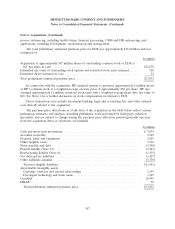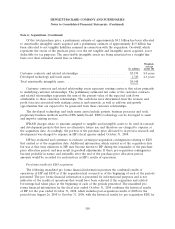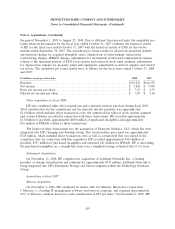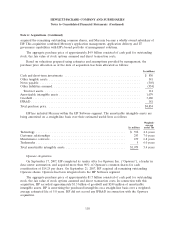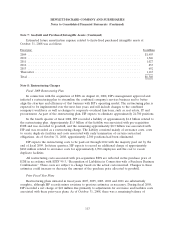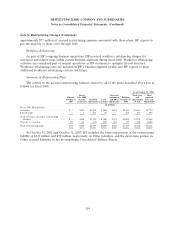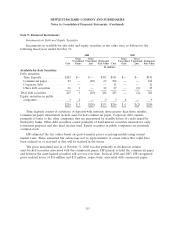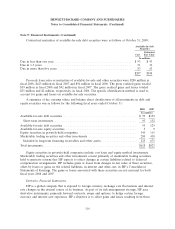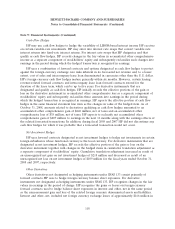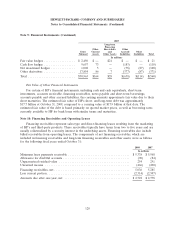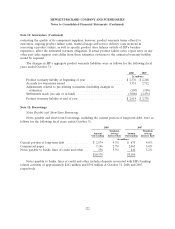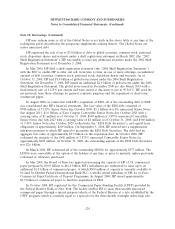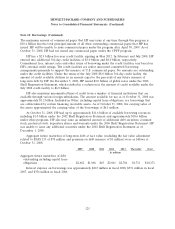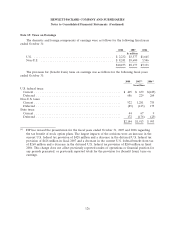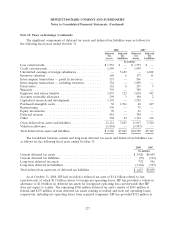HP 2008 Annual Report Download - page 123
Download and view the complete annual report
Please find page 123 of the 2008 HP annual report below. You can navigate through the pages in the report by either clicking on the pages listed below, or by using the keyword search tool below to find specific information within the annual report.HEWLETT-PACKARD COMPANY AND SUBSIDIARIES
Notes to Consolidated Financial Statements (Continued)
Note 9: Financial Instruments (Continued)
exposures with losses and gains on the derivative contracts used to hedge them, thereby reducing
volatility of earnings or protecting fair values of assets and liabilities. HP does not use derivative
contracts for speculative purposes. HP applies hedge accounting based upon the criteria established by
SFAS No. 133, ‘‘Accounting for Derivative Instruments and Hedging Activities’’ (‘‘SFAS 133’’), whereby
HP designates its derivatives as fair value hedges, cash flow hedges or hedges of the foreign currency
exposure of a net investment in a foreign operation (‘‘net investment hedges’’). HP recognizes all
derivatives in the Consolidated Balance Sheets at fair value and reports them in other current assets,
long-term financing receivables and other assets, other accrued liabilities, or other liabilities. HP
classifies cash flows from the derivative programs as cash flows from operating activities in the
Consolidated Statement of Cash Flows.
As a result of the use of derivative instruments, HP is exposed to the risk that counterparties to
derivative contracts will fail to meet their contractual obligations. To mitigate the counterparty credit
risk, HP has a policy of only entering into contracts with carefully selected major financial institutions
based upon their credit ratings and other factors, and maintains strict dollar and term limits that
correspond to each institution’s credit rating. HP’s established policies and procedures for mitigating
credit risk on principal transactions and short term cash include reviewing and establishing limits for
credit exposure and continually assessing the creditworthiness of counterparties. Master agreements
with counterparties include master netting arrangements as further mitigation of credit exposure to
counterparties. These arrangements permit HP to net amounts due from HP to a counterparty with
amounts due to HP from a counterparty reducing the maximum loss from credit risk in the event of
counterparty default.
Fair Value Hedges
HP may enter into fair value hedges to reduce the exposure of its debt portfolio to both interest
rate risk and foreign currency exchange rate risk. HP issues long-term debt in either U.S. dollars or
foreign currencies based on market conditions at the time of financing. HP may then use interest rate
or cross currency swaps to modify the market risk exposures in connection with the debt to achieve
primarily U.S. dollar LIBOR-based floating interest expense and to manage exposure to changes in
foreign currency exchange rates. The swap transactions generally involve the exchange of fixed for
floating interest payments, and, when the underlying debt is denominated in a foreign currency,
exchange of the foreign currency principal and interest obligations for U.S. dollar-denominated
amounts. Alternatively, HP may choose not to swap fixed for floating interest payments or may
terminate a previously executed swap if it believes a larger proportion of fixed-rate debt would be
beneficial. HP may choose not to hedge the foreign currency risk associated with its foreign currency
denominated debt if this debt acts as a natural hedge for foreign currency assets denominated in the
same currency. When investing in fixed rate instruments, HP may enter into interest rate swaps that
convert the fixed interest returns into variable interest returns and would classify these swaps as fair
value hedges. For derivative instruments that are designated and qualify as fair value hedges, HP
recognizes the gain or loss on the derivative instrument, as well as the offsetting loss or gain on the
hedged item in interest and other, net, in the Consolidated Statements of Earnings in the current
period. When HP terminates an interest rate swap before maturity, the resulting gain or loss from the
termination is amortized over the remaining life of the underlying hedged item.
117


